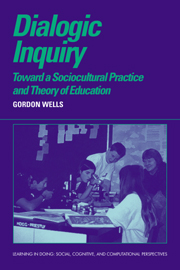Book contents
- Frontmatter
- Contents
- Conventions of Transcription
- Introduction
- Part I Establishing the Theoretical Framework
- Part II Discourse, Learning, and Teaching
- Part III Learning and Teaching in the zpd
- 9 On Learning With and From Our Students
- 10 The Zone of Proximal Development and Its Implications for Learning and Teaching
- Appendix I A Social Constructivist Model of Learning and Teaching
- Appendix II Categories for the Analysis of Discourse
- References
- Index of Authors
- Index of Subjects
- Title in the series
10 - The Zone of Proximal Development and Its Implications for Learning and Teaching
Published online by Cambridge University Press: 09 November 2009
- Frontmatter
- Contents
- Conventions of Transcription
- Introduction
- Part I Establishing the Theoretical Framework
- Part II Discourse, Learning, and Teaching
- Part III Learning and Teaching in the zpd
- 9 On Learning With and From Our Students
- 10 The Zone of Proximal Development and Its Implications for Learning and Teaching
- Appendix I A Social Constructivist Model of Learning and Teaching
- Appendix II Categories for the Analysis of Discourse
- References
- Index of Authors
- Index of Subjects
- Title in the series
Summary
There can be little doubt that, in the English-speaking world at least, it is the “zone of proximal development” that has been Vygotsky's most important legacy to education. Indeed, it is the only aspect of Vygotsky's genetic theory of human development that most teachers have ever heard of and, as a result, it is not infrequently cited to justify forms of teaching that seem quite incompatible with the theory as a whole. This centenary conference therefore seems an appropriate occasion to review Vygotsky's exposition of the zpd and to consider the ways in which this seminal concept has been modified and extended in subsequent work.
Although the zpd is often said to be a central concept within his theory, its explicit formulation appeared quite late in Vygotsky's writings and then in two rather different contexts. One version, translated into English as “Interaction between Learning and Development” (chapter 6 of Mind in Society, 1978), occurred in a posthumously published collection of essays entitled Mental Development of Children and the Processes of Learning (Vygotsky, 1935). Here, the immediate context in which the concept of the zpd is presented is that of the assessment of children's intellectual abilities and, more specifically, as a more dynamic conception of intellectual potential than that represented by an IQ score. Vygotsky defines the zone of proximal development as “the distance between the actual developmental level as determined by independent problem solving and the level of potential development as determined through problem solving under adult guidance or in collaboration with more capable peers” (1978, p. 86).
- Type
- Chapter
- Information
- Dialogic InquiryTowards a Socio-cultural Practice and Theory of Education, pp. 313 - 334Publisher: Cambridge University PressPrint publication year: 1999
- 8
- Cited by



